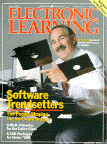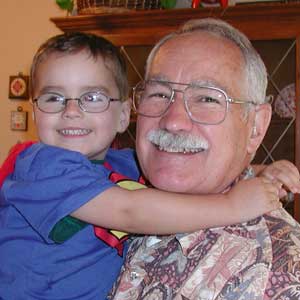- Home
- About Us
- Global SchoolNet's Team
- About GSN's Founders
Founders
From the earliest days of the Internet, Al Rogers and Yvonne Andres have been passionately committed to discovering, demonstrating and documenting the incredible power of Internet-based learning
In recognition of their pioneering work in telecommunications, The December 2001 issue of the District Administration Magazine cited the team of Al Rogers and Yvonne Andres as one of the all-time Top 25 Educational Technology Advocates.

Dr. Yvonne Marie Andres is the President and CEO of the Global SchoolNet Foundation, founder of the Global Schoolhouse and is a former Vice President of Internet Learning Programs and Partnerships at Lightspan, Inc. Andres was inducted into the Internet Hall of Fame in 2017 for her life time work and global social impact..
An educator for nearly two decades, Dr. Andres has taught pre-school through university and is dedicated to discovering, demonstrating, and documenting the power of "Internet style learning."
Dr. Andres has also designed and taught many courses, including "Hello Internet," "Managing Global Learning Projects," "Designing On-line Courses," and "Creating Effective Educational Websites." Ms. Andres' activities include promoting and facilitating exciting and innovative Internet learning projects, including International CyberFair.
Dr. Andres has been champion of instructional telecommunications since 1984, as an electronic bulletin board sysop and project director for various networks including the AT&T Learning Network, CORE (California Online Resources in Education) Network, CERFnet (California Education and Research Federation) and the FrEdMail Network. She has provided leadership and training in educational telecommunications at conferences and workshops throughout the U.S., Canada, Asia, Europe, Australia, South America and Africa. She also designed a pilot interactive Internet video project with ABC World News Now.
In 1988, she co-authored "TeleSensations: The Educators' Handbook to Instructional TeleComputing" and for seven years served as the editor of an international newsletter focusing on collaborative telecomputing projects. She has helped develop hundreds of successful online projects, two of which were selected as model telelessons by the California Educational Technology Committee. Dr. Andres has written dozens of articles, is the winner of the 1989 Computer Learning Month's Telecommunications Lesson Plan contest and is featured on the cover of the May 1990 Teaching and Computers with some students in "Telecommunicating from Sea to Shining Sea."

Andres developed and coordinated the original Global Schoolhouse Project, electronically bringing together students from schools in Knoxville, Tennessee, Arlington, Virginia, Oceanside, California, and London, England. Students, grades 5 through 8, conducted an environmental study of watershed pollution and shared their findings via state-of-the-art video conferencing using desktop computers and the Internet. The project was expanded to include twenty schools in 12 states who used the Internet to study alternative energy sources, space exploration, natural disasters, and waste management.
In 1992, Dr. Andres authored, "CERF'n Safari: An Educators' Guide to the Internet," the very first teacher's Internet guide! In September 1994, Dr. Andres accepted an appointment to the Governor's Information Technology Council for the State of California, where she helped author "Getting Results." Dr. Andres is also a co-author of "Going to School on the Internet" (a publication of Cisco Systems) and "Harnessing the Power of the Web for Classroom Use: A Tutorial." Andres also authored Apple's "Getting Started on the Internet." In 1996, Andres was selected as a Woman of Merit and in 1997, as one of the 100 most influential people in U.S. public education Most recently, Dr. Andres was named one of the 30 most influential people, nationwide, in education technology by eSchool News. Learn more at: yvonneandres.com and Yvonne Marie Andres.

Al is one of the earliest pioneers in the use of computers in teaching. When he got started... in the days of the IMSAI and Altair (1975-1976)... the only way to obtain a computer was to assemble one from scratch... including soldering IC sockets, capacitors, resistors, and I/O plugs to a blank S-100 mother board. His first classroom computer video monitor was a bare CRT housed in a cardboard box with a window cut in one side.
His "mass storage" unit was a portable cassette tape recorder. He and his 6th grade students used this state-of-the-art machine to explore programming NIM, Hangman and other logic games in MITS 8K BASIC (produced by a tiny company named Microsoft). Other microcomputer hobbyists (there were no professionals then) envied his old Model 33 Teletype printer (10 CPS/noisy/upper case only).
By 1978, after acquiring five of the earliest Commodore PET's Al and a colleague were teaching 4th, 5th and 6th grade students within a school-based computer "mini-magnet." By 1981 he had established a district-wide computer magnet program in a lab of 21 networked Apple IIe's (with a 10MB hard disk!).
Early on, Al discovered the importance of the computer as a learning tool. Al believes that what you do with technology is far more important than what technology you have. "A good teacher does not need the latest and greatest tools. But good technology can also be a catalyst to develop good teaching, especially when you use them as tools. Implementing word processing, spread sheets, databases, and Internet communications in your coursework makes you focus on good-quality teaching."

This has been reflected in Al's work in the years since. Al achieved a degree of recognition in the early days of educational computing as the author of FrEdWriter, a free teacher- and student-friendly word processor.
In 1985 he also wrote and launched the FrEdMail Network, a popular Apple IIe-based pre-internet telecommunications network to exchange student writing. In 2005, in the 25th Anniversary issue of Teaching and Learning Magazine, the FrEdMail Network was recognized as one of the top fifteen "Breakthrough Products" of the previous 25 years (item #12)."
Al developed these two tools to support the well-researched principle that "Students will write when they have a sympathetic, interested audience and something to say." This is also a major foundational principle of the Global SchoolNet Foundation which he and Yvonne founded in 1990, along with the participation of over 300 FrEdMail sysops.
Al and Yvonne made an early contribution to the literature and practice of the use of telecommunications in the classroom. Many of their early articles are classics in the literature. These articles remain current and are mainstays in many graduate and undergraduate Internet programs.

Al's work was also influential among educators beginning to use the Internet in its early days. His "Harnessing the Power of the Web" CD-ROM was distributed as part of the Thinkquest Competition to over 500,000 teachers around the world. He also served as a member of the Board of Directors of the International Society for Technology in Education (http://www.iste.org/).
Al is currently in retirement enjoying his eight grandchildren & country lifestyle in Ramona, CA. However, he continues to volunteer his time as GSN Webmaster and keeps everything functioning smoothly.
Achievements, Honors and Awards
Al has received many awards over the years.
- 1999: At NECC '99, the International Society for Technology in Education recognized Al as a NECC Pioneer... one of 20 distinguished educational leaders from all levels who have been pioneers and leaders in bringing educational technology to schools around the country.
- 2001: Technology & Learning Magazine's November article on the "Top 10 Technology Breakthroughs for Schools" cited Global SchoolNet as a leader in their breakthrough category #3: Collaboration Tools.
- 2001: District Administrator Magazine's November article cited Al and Yvonne among their list of "Top 25 Technology Advocates".
- 1994: ISTE Distinguished Service Award for Contributions to Telecommunications in Education
- 1991: Named one of ten "Educators of the Decade" by Electronic Learning magazine
- 1991: CUE (California Computer-Using Educators) Platinum Disk Award 1991
- 1986 and 1988: Two CUE Gold Disk awards 1986, 1987 (view 1986 disk)
- 1987: Cover of Electronic Learning magazine in recognition of his free program FrEdWriter, once the most widely used word processor in the United States